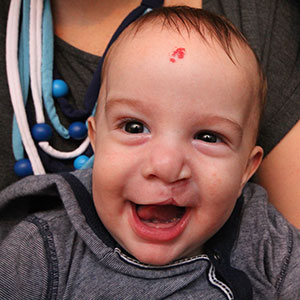Speech is a simple act with complicated anatomy. We need our lungs, throat, mouth, tongue, teeth and even our nose to work in tandem to produce words, and we need our ears functioning well so that we can learn to speak. Problems with any of these structures can impact a child’s speech development. Children with speech problems are frequently referred to Pediatric ENT of Oklahoma. When you visit Dr. Glade at our OKC offices, he’ll examine your child for structural concerns like these.
Physical Versus Neurological Abnormalities
Speech development issues come in two main types. The first is physical. Any basic anatomical issue that hinders speech development is considered a physical cause. This category includes everything from blocked Eustachian tubes impeding hearing to complex air flow problems from a cleft palate.
The second type is neurological. This category is sweeping and includes issues like nerve damage that impacts hearing and developmental delays from Down syndrome. One of the more common causes is apraxia, a disorder that prevents the brain from coordinating speech muscles.
The differences between a physically- and neurologically-based speech dysfunction can be subtle. Something as small as a breath sound can be the key. It takes specialized training and diagnostic testing to tell the difference. At Pediatric ENT of Oklahoma, we’re equipped to differentiate between the underlying causes of speech disorders and specialize in treating physical causes.
 Cleft Lip and Cleft Palate
Cleft Lip and Cleft Palate
Cleft lip and cleft palate are usually diagnosed at birth. However, costs can prevent parents from getting it addressed and very minor abnormalities can be missed. As the children grow up, a cleft can impact their ability to form words properly with their lip and control breath sounds with the cleft.
A cleft palate can be especially problematic. A cleft palate opens the roof of the mouth directly into the nose. Instead of flowing directly out of the mouth during speech, air can “get lost” in the nasal cavity. This is called velopharyngeal insufficiency, and it often causes issues with swallowing and breathing as well. Our Dr. Glade is an OKC cleft palate specialist and recognized expert in the repair of cleft lip and palate.
Velopharyngeal Insufficiency
Velopharyngeal insufficiency, or VPI, occurs when the gap between the back of the throat and the soft palate doesn’t close during speech. In a healthy mouth, the soft palate pushes up against the opening to the nasal passages when we speak and swallow. Air can’t flow in or out of the nose. In children with VPI, the gap doesn’t close and air flow weakens the voice.
VPI can be caused by a variety of physical abnormalities, including:
• Cleft palate
• Abnormal pharynx shape
• Enlarged tonsils
• Short soft palate
Apraxia, VPI and other structural abnormalities can be tricky to tell apart. Specialists like Dr. Glade in OKC are trained to identify the subtle differences. Diagnostics like contrast-aided x-rays let us to watch how your child’s throat functions when they swallow and speak, allowing a correct diagnosis to be made.
Eustachian Tube Dysfunction
One of the most important ways children learn how to speak is by hearing us speak to them. When hearing is impeded, children have difficulty learning how to speak properly, adding to their vocabulary and developing proper speech comprehension skills. Eustachian tube dysfunction is a frequent cause of mild to moderate hearing loss in young children.
Eustachian tubes are tiny corridors that connect our outer and inner ear. They balance air pressure in our ears and drain any fluid that collects inside them. You may be able to hear them opening when you swallow. Chronic inflammation and infection in the Eustachian tubes causes swelling and blockages. Clear sound can’t reach the inner ear, and your child’s hearing is significantly impacted.
Common causes of Eustachian tube dysfunction include:
• Allergies
• Chronic infection
• Cleft palate
• Risk factors like a parent who smokes
Lip and Tongue Tie
Look in a mirror, open your mouth and curl your tongue all the way back. You’ll see a thin band of tissue anchoring your tongue to the floor of your mouth. That band of tissue is called a frenum, and you’ll find another connecting your gum line to your upper lip.
If the frenum on the tongue runs too far toward the tip of the tongue, it can hold the tongue against the bottom of the mouth. This is called “tongue tie,” and it can prevent your child from making proper speech sounds. If the frenum on the upper lip is similarly constricting, called a “lip tie,” it can also impede speech. Restrictive frena can also be uncomfortable and cause swallowing dysfunctions.
The physical causes of speech development issues can be addressed with proper diagnostics and treatment. Schedule an appointment today to meet Dr. Glade, your OKC ENT specialist, to have your child’s unique situation evaluated.

